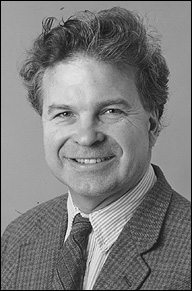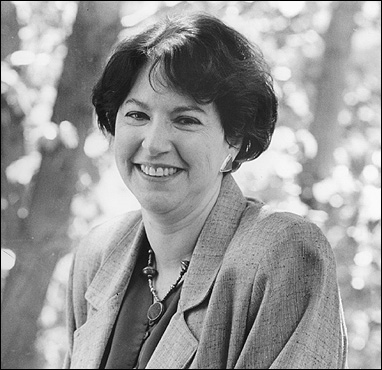![]()
Departments
![]()

|
Week of 30 October 1998 |
Vol. II, No. 12 |
Feature
Article
New Horizons in Science conference
A heads-up on tomorrow's headlines
By Eric McHenry
Few newspapers, Ben Patrusky says, have the budget to field a phalanx of science writers. So while most scientists are subspecialists, most science journalists are generalists.
|
|
|
H. Eugene Stanley |
For science writers, one of the conference's most attractive features is the opportunity to hear from leading researchers, who will present and interpret their latest findings in a series of symposia. Patrusky, who has organized the conference for 24 years, seeks out scientists whose recent work is both groundbreaking and potentially newsworthy.
"My job is to stay ahead of the curve," he says. "Everybody's getting the same journals, and so I have to work hard to surprise people."
While some attendees will publish stories based on what they learn at the briefing, its first purpose is to provide reporters with a sense of context and assist in longer-term editorial planning.
Background beforehand
"New Horizons is not geared toward breaking news," says
Robert Cowen, science correspondent for the Christian
Science Monitor and a longtime participant in the
conference. "It's meant mainly to give writers a heads-up on
where things are going. It provides background and points us
in the right direction for trend stories."
It also gives the journalists a chance to network, both with professional colleagues and with potential sources, Cowen says.
"The scientists are the conference's guests, and some of them stay for several days. So we get to see them at lunch and dinner, and interact with them quite a bit. It's different from the typical briefing in that respect."
Such interaction is beneficial not only to journalists, says David Lampe, BU associate vice president for University Relations, but to participating scientists, and by extension, participating universities as well.
"We saw this as an opportunity to help BU gain broader recognition as the great research institution that it is, a chance to build relationships with the people who control the flow of information," says Lampe, whose office coordinated the conference from the University's end. "New Horizons has immediate value in that we can spotlight faculty here, but it has a longer-term value in that we can build a relationship with the press that is necessary for people to see who we are and where we're going."
BU will be well represented at the conference, contributing 8 of the 17 scheduled presenters. That's evidence of the University's broad-based strength in the sciences, Patrusky says. The CASW board looks most favorably upon prominent research institutions as prospective host sites for the briefing. But hosting New Horizons does not assure a school any number of slots on the program.
Scientific hotbed
"There's no quid pro quo," he says. "Each spring I go to
the host school, and I spend a lot of time talking to
faculty members. At BU, I set up appointments and spent five
days bouncing around the campus and talking to about 40
scientists. I knew there'd be some good science there
because it's Boston University. But I didn't know, because
we had accepted the school's bid back in 1993, what the
nature of the science would be or if it would be appropriate
to the program."
Patrusky singled out H. Eugene Stanley, CAS professor of physics and director of the Center for Polymer Studies, for his research on the role of senile plaques in the advancement of Alzheimer's disease. Senile plaques are peptide deposits that are more abundant on the brains of Alzheimer's sufferers, and are therefore believed either to be a cause or a symptom of the enigmatic disease.
It's no surprise, Stanley says, that his work is deemed of interest to science journalists. "I was probably chosen not for my speaking abilities," he says, "but because Alzheimer's is something that about 30 percent of us will get."
Most researchers who study Alzheimer's have training in the biological sciences and are interested in approaching the problem clinically. Stanley believes that equally promising research lies in the aggregation and disaggregation, or development and decay, of senile plaques. He suspects that such plaques either collect more quickly or break down more slowly on the brains of Alzheimer's sufferers. Testing these hypotheses entails the use of aggregation models, which are the tools of statistical physicists.
Stanley's presentation, entitled The Physics of Alzheimer's Disease, is one of three to be given by BU researchers on the morning of November 4. Nancy Kopell, CAS professor of mathematics, and James Collins, ENG professor of biomedical engineering, will speak about The Mathematics of the Central Nervous System and The Mathematics of the Cell Cycle, respectively. Patrusky has grouped the three under the rubric New Synergisms. He says he planned the conference with an eye toward "interesting hybrids, different disciplines interacting as a way of getting answers to rather tortuous science questions."
"Much of academic science tends to be highly disciplinary, but the world is, in fact, inherently interdisciplinary," says Lampe. "Many of BU's programs reflect that reality, and the conference organizers seized on that."
Kopell's work in mathematics, for example, might ultimately inform the development of therapies for thought disorders. At the briefing, she will discuss the neural rhythms that are believed to be related to awareness, perception, and attention, and why mathematics helps to understand how the brain produces and uses them.
"Pathologies in these rhythms are associated with thought disorders such as schizophrenia," she says, "so understanding what creates or disrupts them has implications for treatment."
For more information about the New Horizons in Science briefing, visit http://www.bu.edu/casw.
|
|
|
Nancy Kopell |

